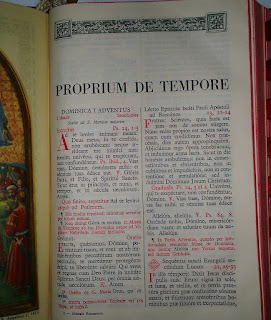Glancing, briefly, at the Sanctorale section of the new missal (the Calendar changes will be fully discussed in a later part of this series), the notable change is the re-classification of feasts into I, II, III and IV class (c.f. classification system in the 1970 Missal and Memoria sulla riforma litugica: Supplemento I: Intorno alla graduazione liturgica, SRC Sectio historica 75, 1950). Also, as mentioned several times in our regular series of posts the feast of the Purification of the BVM had a makeover and became a feast of the LORD, the colour for the blessing of candles and procession became white and the prayers of blessing were changed with the short conclusion replacing the traditional form (c.f. blessing of Palms etc).
Following the Sanctorale section several changes were made to the two series of Votive Masses. The first series remained unscathed except for a recasting of the rubric governing their, possible, use as Conventual Masses. As we shall see when Votive Masses are discussed later in this series the rubrics of 1962MR are far more liberal in allowing Votive Masses. The second series of Votive Masses, Missae Votivae ad Diversa, underwent more substantial changes. The series became numbered and saw several 'sanitizations' of the titles of the various Masses. The Mass against the Pagans became '19. Missa pro Ecclesiae Defensione' and the Mass for the ending of a schism became '20. Missa pro Ecclesiae Unitate' although the text of both remained unchanged. The word 'refugees' was added to the title of the Mass for Pilgrims and Travellers, '25. Missa pro Peregrinantibus, iter Agentibus et Profugis'. Following the inclusion in the Rituale in 1952 of a blessing to mark the twenty-fifth and fiftieth anniversaries of a marriage a new Mass rubric was inserted, '12. In 25° et 50° Anniversario a celebratione Matrimonii'. Five new Mass formularies were added for the profession of religious, men and women, for the grant and preservation of ecclesiastical and religious vocations: '13. Missa in Die Professionis Religiosorum'; '14. Missa in Die Professionis Religiosarum'; '15. Missa ad Vocationes Ecclesiasticas Petendas'; '16. Missa ad Vocationes Ecclesiasticas Servandas'; and, '17. Missa ad Vocationes Religiosas Petendas et Fovendas'.
The prayers for divers occasions underwent a similar renumbering and changes. The former series of prayers for the Emperor (No. 5 trad. style) and for Public Penitents (No. 23 trad. style) were abolished. These were replaced by series for the Bishop (No. 7 new style) and for Public Rulers (No. 9 new style), c.f. the new Good Friday orations. The series for the gift of tears (of sorrow) (No. 21 trad. style) became '22. Ad petendem compunctionem cordis. The series between No. 8 (new style) and No. 12 were re-distributed with minor sanitization of some of their titles.
(Burial Service - Note the De profundis and associated prayers for the Faithful Departed)
After the section giving the forms of the Requiem Mass there were changes made to the Burial Service. In 1962MR the antiphon Ego sum (in full) and the Benedictus (along with De profundis and other psalms from the Office of the Dead) are begun immediately after In paradisum and continued during the procession to the grave. At the conclusion of the burial (or after the Absolution of a Catafalque) the De profundis and the other prayers for the souls of the faithful departed are omitted.
(1962MR - Burial Service)
(Blessing of Lustral Water)
In the rite for blessing of lustral water the prayers all now have the short conclusion and salt is only added once into the water, not three times as in the traditional rite. During the Asperges ceremony the celebrant no longer recites the psalm Miserere (or Confitemini in Paschaltide) in a low voice whilst he asperses the people.
(1962MR - Blessing of Lustral Water)
In the last section of the Missal giving Masses pro aliquibus locis there were substantial deletions: e.g. the Translation of the Holy House (10 Dec); the Expectation of the BVM (18 Dec); the Espousals of the BVM (23 Jan); the Flight into Egypt (17 Feb); the Prayer of OLJC (Tuesday after Septuagesima); the Crown of Thorns (Friday after Ash Wednesday); the Spear and Lance (Friday after the first Sunday in Lent); the Winding Sheet of OLJC (Friday after the second Sunday in Lent); the Five Wounds (Friday after the third Sunday in Lent); St. Philomena (11 Aug) etc. Masses of feasts suppressed in the Calendar, e.g. St. John before the Latin Gate were added to this section.This post concludes the first section of our article on the 1962MR. In describing some of the changes found in the editions of the 1962MR it must be born in mind that no one was obliged to use a copy of this short-lived edition. What was of obligation was to use the rite it contained. In the last section of the series we will look at the comments of those involved in the stages of the reform both before and after 1962MR and how it was perceived as a step in the process and that Missals, and Breviaries, were a convenience, not a necessity.
Section 2 will examine the changes to the rite of Mass as found in the 1962MR. (My apologies to readers for the late posting of this final part of Section 1).






















